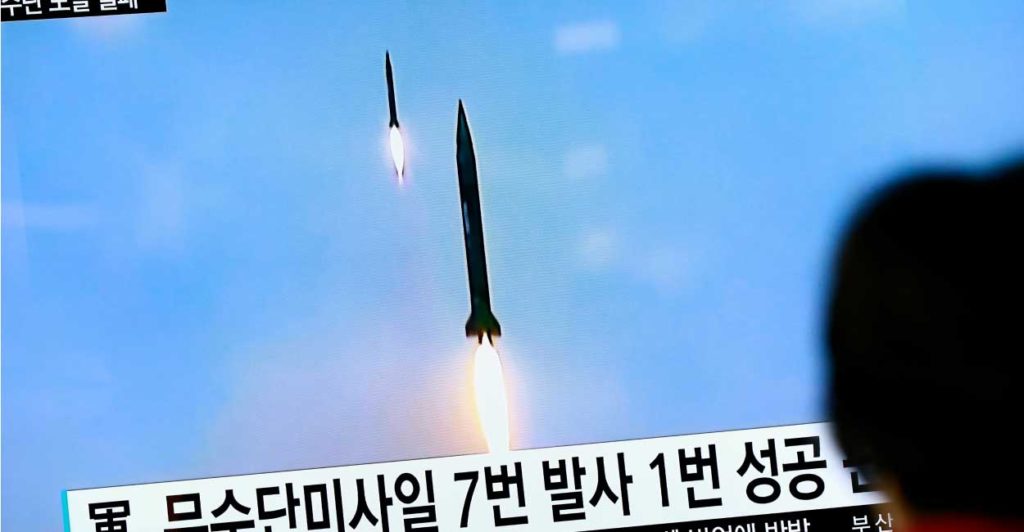Pyongyang launched another ballistic missile on Saturday, raising tensions and pushing itself to the top of the Trump administration’s policy agenda.
On Feb. 12, North Korea claimed it had successfully launched a new nuclear-capable medium-range missile fired from a mobile launcher. The missile reportedly used a new solid-fueled engine capable of evasive maneuvers during flight. Such a missile would be a significant improvement over the existing No Dong medium-range missile.
Preliminary reports indicate the missile flew approximately 300 miles indicating it was not the initial test flight of an ICBM that Pyongyang had vowed to launch “anywhere, anytime.”
Last year, North Korea conducted two nuclear tests and 24 ballistic missile tests, its most extensive year of testing. Pyongyang had not tested a missile since October, leading to speculation that the regime’s restraint was to not give the advantage to conservative candidates during a forthcoming South Korean presidential election or to wait until the Trump administration had completed its North Korea policy review.
In 2009, North Korea conducted a long-range missile test and a nuclear test as the Obama administration was formulating its own policy toward Pyongyang.
During my meetings in Seoul this week, all senior U.S. and South Korean officials expected a missile launch wouldn’t occur for several more months. It is unclear why Pyongyang abandoned its testing hiatus or chose to do so while President Donald Trump was hosting Japanese Prime Minister Shinzo Abe.
In any case, the launch will undermine those in the U.S. and South Korea advocating resumption of long-stalled negotiations to curb North Korea’s nuclear and missile programs.
The increasing North Korean threat has aggravated long-standing allied concerns of U.S. abandonment exacerbated by perceptions of diminished U.S. military capabilities and resolve during the Obama administration and comments made by Trump during the campaign suggesting conditionality of U.S. troop presence in Asia.
Secretary of Defense James Mattis’ trip to Seoul and Tokyo last week assuaged much of the allied concerns, though as one senior South Korea official commented, “the concerns are gone, but anxiety remains.”
In recent months, there have been growing South Korean fears of a decoupled alliance in which the U.S. “wouldn’t trade Los Angeles for Seoul” once North Korea demonstrates an unambiguous capability to threaten the continental U.S. with nuclear ICBMs.
This has led to greater advocacy in South Korea for a range of military options, including the reintroduction of U.S. tactical nuclear weapons that were withdrawn in the 1990s, development of an indigenous South Korean nuclear program, and greater reliance on preemption strategies.
The Trump administration should build on the positive momentum generated from its recent affirmation of its “ironclad commitment” to defend South Korea and Japan by closely coordinating on an allied response.
The launch is yet another violation of United Nations resolutions prohibiting any North Korean launch using ballistic missile technology and the allies should press Beijing for further restrictions on North Korea financial activity, most notably coal exports to China.
Given Chinese foot-dragging on fully implementing required U.N. resolution sanctions, the Trump administration should go beyond the timid incrementalism of the Obama administration by more vigorously enforcing U.S. laws against North Korean transgressions.
While President Barack Obama talked a good game on sanctions, his administration pulled its punches, sanctioning a limited number of entities while holding other actions in abeyance until the next North Korean provocation. Obama’s most significant actions against the regime last year were the result of requirements contained in Congress’ North Korea Sanctions and Policy Enhancement Act.
The Trump administration should use the extensive authorities already contained in existing legislation and executive orders to impose targeted financial measures against a broader array of North Korean entities. Just as importantly, the U.S. should end its self-imposed restraint against third-party sanctions against Chinese entities facilitating North Korea’s nuclear and missile programs.
Washington should also consult with Seoul to accelerate the planned deployment of the THAAD (Terminal High Altitude Area Defense) ballistic missile defense system to South Korea.
Both governments have agreed to the deployment but it is not scheduled to occur until later this year. North Korea’s resumption of missile tests shows the need to more quickly augment allied defenses.
The U.S. and South Korea should continue the planned annual Key Resolve and Foal Eagle joint military exercises which begin in early March. Washington should reassure our allies by including U.S. strategic assets, such as B-52 and B-2 bombers as well as dual-capable aircraft and nuclear naval vessels.
However, the allies should tone down public messaging about “decapitation attacks” and preemptive strikes that are potentially destabilizing and could lead either side to misinterpret the other’s intentions, fueling tension and raising the risk of miscalculation.
Responding to the growing North Korean nuclear and missile threats is like a military version of playing “whack-a-mole.” Unlike the arcade game, however, in the real world there is the very real danger that the mole will whack back.
This article has been updated.
